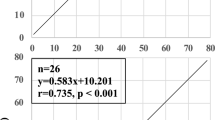Abstract
Measurement of end-tidal carbon dioxide tension (PetCO2) by mass spectrometry or infrared capnometry provides a clinically useful approximation of arterial carbon dioxide tension (PaCO2) in intubated patients. Although several devices have been proposed to samplePetCO2 during spontaneous breathing (i.e., unintubated patients receiving supplemental oxygen), thus far no reports have documented their efficacy. This article reports the use of an easily constructed modification of simple nasal cannulae that permits accurate sampling ofPetCO2 during oxygen administration to unintubated patients. After amputation of the closed tip, a cap from a syringe was inserted via a slit made at the base into one prong of a pair of nasal cannulae. A capnometer was connected to the syringe cap, andPetCO2 and PaCO2 were determined simultaneously during the administration of 3 L/min oxygen via nasal cannulae to 21 normocapnic patients. The PaCO2 —PetCO2 gradients were calculated and compared with values obtained in the same patients after intubation and mechanical ventilation. No significant difference was found between the calculated gradients with nasal cannulae (2.09±2.18 mm Hg) versus intubation (2.87±2.82 mm Hg). Simultaneous oxygen administration and accurate sampling ofPetCO2 may be achieved in unintubated patients by using this easily constructed modification of nasal cannulae.
Similar content being viewed by others
References
Nunn JH, Hill DW. Respiratory deadspace and arterial to end-tidal CO2 tension difference in anesthetized man. J Appl Physiol 1960;15:383–389
Takki S, Aromaa U, Kauste A. The validity and usefulness of the end-tidal PCO2 during anesthesia. Ann Clin Res 1972;4:278–284
Whitesell R, Asiddao C, Gollman D, Jablonski J. Relationship between arterial and peak expired carbon dioxide pressure during anesthesia and factors influencing the difference. Anesth Analg 1981;60:508–512
Raemer DB, Francis D, Philip JH, Gabel RA. Variation in PCO2 between aterial blood and peak expired gas during anesthesia. Anesth Analg 1983;62:1065–1069
Ibarra E, Lees DE. Mass spectrometer monitoring of patients with regional anesthesia. Anesthesiology 1985;63:572–573
Goldman JM. A simple, easy, and inexpensive method for monitoring ETCO2 through nasal cannulae. Anesthesiology 1987;67:606
Huntington CT, King H. A simpler design for mass spectrometer monitoring of the awake patient. Anesthesiology 1986;65:565–566
Norman EA, Zeig NG, Ahmad I. Better designs for mass spectrometer monitoring of the awake patient. Anesthesiology 1986;64:664
Pressman MA. A simple method of measuring ETCO2 during MAC and major regional anesthesia. Anesth Analg 1988;67:905–906
Urmey WF. Accuracy of expired carbon dioxide partial pressure sampled from a nasal cannula I. Anesthesiology 1988;67:959–960
Dunphy JA. Accuracy of expired carbon dioxide partial pressure sampled from a nasal cannula II. Anesthesiology 1988;68:960–961
Goldman JM. Accuracy of expired carbon dioxide partial pressure sampled from nasal cannula. In reply. Anesthesiology 1988;68:961–962
Bergman NA. Effects of varying waveforms on gas exchange. Anesthesiology 1967;28:390–395
Fairley HB, Blenkarn GD. Effect on pulmonary gas exchange of variations in inspiratory flow rate during intermittent positive pressure ventilation. Br J Anaesth 1966;38:320–328
Ryerson GG, Block AJ. Oxygen as a drug: chemical properties, benefits and hazards of administration. In: Burton CC, Hodgkin JE, eds. Respiratory care: a guide to clinical practice (2nd ed.). Philadelphia: Lippincott, 1984:395–415
Author information
Authors and Affiliations
Additional information
Supported in part by PPG Biomedical Systems, Lenexa, KS.
The apparatus and method described herein are covered by U.S. Patent Application S.N. 181,814: Method and Apparatus for Inhalation of Treating Gas for Quantitative Analysis. Filed April 15, 1988—in the name of Edwin A. Bowe, et al.
Rights and permissions
About this article
Cite this article
Bowe, E.A., Boysen, P.G., Broome, J.A. et al. Accurate determination of end-tidal carbon dioxide during administration of oxygen by nasal cannulae. J Clin Monitor Comput 5, 105–110 (1989). https://doi.org/10.1007/BF01617883
Received:
Revised:
Accepted:
Issue Date:
DOI: https://doi.org/10.1007/BF01617883




